Project 4 / Scene Recognition with Bag of Words

Results of an example classifier
This project focuses on image recognition and classification. Given a set of labelled images, we want to classify a set of unknown images into these labels by comparing them to the labelled ones. There are a number of ways to do this, so we started with simpler algorithms to build a base pipeline. From there, we replaced each algorithm piece by piece with a more complex but more accurate one. The algorithms were implemented in the following order:
- Tiny images representation and nearest neighbor classifier
- Bag of SIFT representation and nearest neighbor classifier
- Bag of SIFT representation and linear SVM classifier
The two types of feature extraction here are conversion to tiny images and bag of SIFT. The two types of classifiers tested are k nearest neighbor and linear SVM.
Tiny Images
Converting images into smaller, more manageable versions of themselves is a workable yet naive way to extract features. The way this works is by downsizing an image to a version with 16x16 pixels. These pixels are what define the features for each image. This allows for fast comparison, but it also ignores things like the high frequency values and spatial or brightness shifts.
K Nearest Neighbor
Using the given features for a set of training images and their matching labels, this algorithm works to classify a set of test images. For each image, it essentially compares its features against the features of each of the training images. It is then classified as the majority vote amongst the k most similar images from the training set. For k, I tried both 1 and 5. For k=1, I simply chose the class of the closest neighbor for the image. For 5, I used the code below to pick. I gave each neighbor a weight based on their distance from the image and added the weights for each class it could be, selecting the class with the highest weight. k=5 gave me a 1% increase in accuracy over k=1 while using Tiny Images, and a 4.4% increase on my main Bag of SIFT implementation.map = containers.Map;
for j = 1:k
word = train_labels{I(j)};
if ~isKey(map,word)
map(word) = 1/val(j);
else
map(word) = map(word) + 1/val(j);
end
end
max = {'',0};
key = keys(map);
value = values(map);
for j = 1:map.Count
if value{j} > max{2}
max = {key{j},value{j}};
end
endBag of SIFT
Bag of SIFT is another feature extraction method. However, this one is much more accurate and powerful. It extracts the SIFT features of each image to start with. For the training set, these sift features are clustered into k groups. The features of the test image are then dumped in these bins to develop a histogram for which types of objects the image contains. This histogram becomes the feature of the image. Below, we can see a few examples across decreasing step sizes. As the step sizes get smaller, the algorithm gets more accurate, but also a lot slower. The lowest accuracy is 39.5% and it goes all the way to 49.7%. I stuck with the second iteration as my step size to keep the time under 4 minutes.
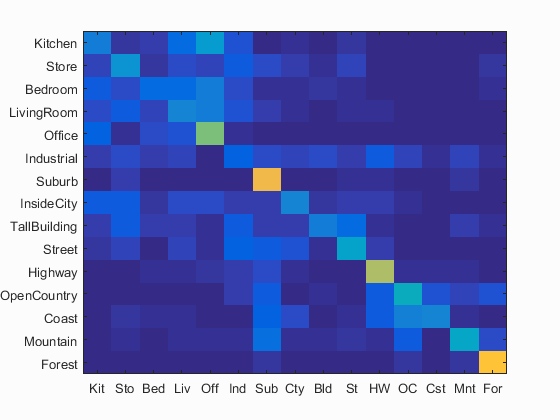
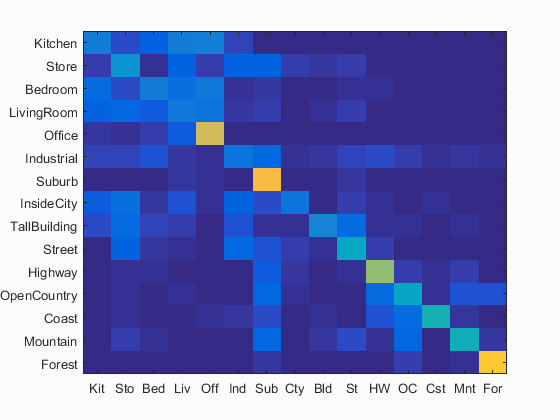
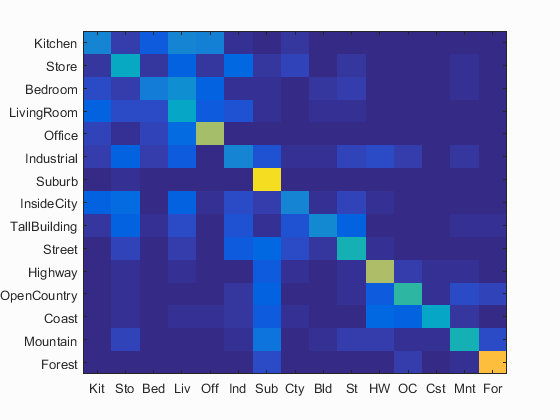
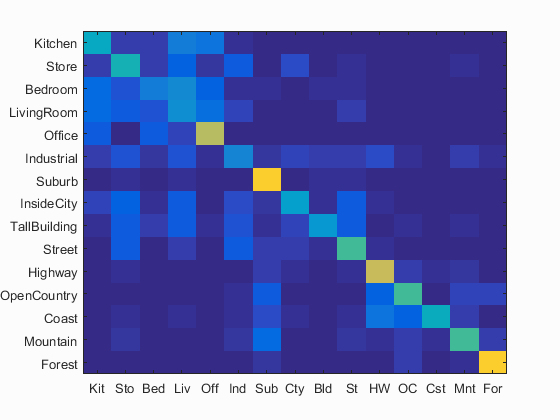
|
Linear SVM
The linear SVM is another method of classifying images based on given features. This one trains a linear classifier so that it can apply itself to new features to classify them. linear SVMs are binary classifiers, so I had to train 15, one for each class. Each class' linear SVM sorted each image as either a member or not a member with a certain weight. The major adjustable input here was lambda, a value which determines how much weight is given to each change. This helps to keep the scaling of the effect of each training image on the classifier either high or low. This has a huge effect on accuracy. Here are some samples from a high lambda (10) and a low one(.000001). The best had an accuracy of 51%.
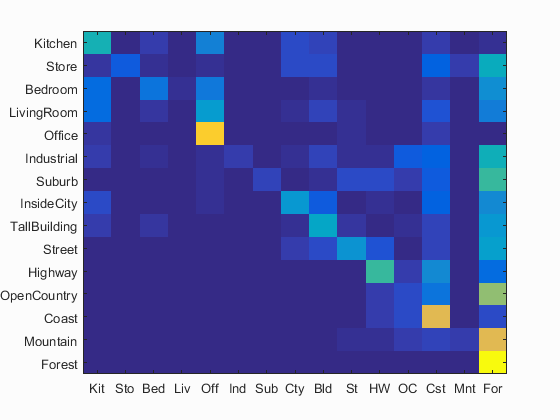
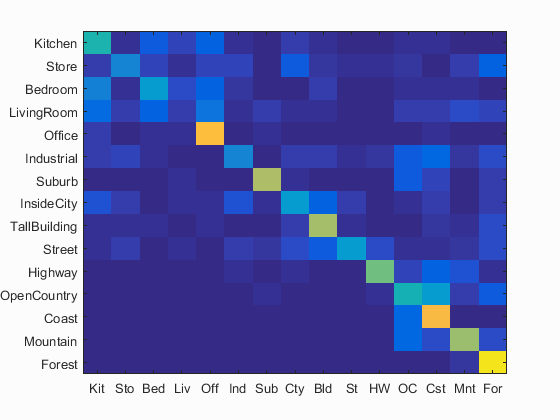
|

Accuracy (mean of diagonal of confusion matrix) is 0.261
| Category name | Accuracy | Sample training images | Sample true positives | False positives with true label | False negatives with wrong predicted label | ||||
|---|---|---|---|---|---|---|---|---|---|
| Kitchen | 0.080 |  |
 |
 |
 |
 Industrial |
 Forest |
 Highway |
 Forest |
| Store | 0.040 |  |
 |
 |
 |
 Office |
 TallBuilding |
 TallBuilding |
 Coast |
| Bedroom | 0.200 |  |
 |
 |
 |
 InsideCity |
 Store |
 OpenCountry |
 Mountain |
| LivingRoom | 0.100 |  |
 |
 |
 |
 Office |
 Kitchen |
 Bedroom |
 Office |
| Office | 0.190 |  |
 |
 |
 |
 Mountain |
 Bedroom |
 Industrial |
 InsideCity |
| Industrial | 0.130 |  |
 |
 |
 |
 LivingRoom |
 TallBuilding |
 InsideCity |
 Store |
| Suburb | 0.470 |  |
 |
 |
 |
 Coast |
 InsideCity |
 Kitchen |
 Street |
| InsideCity | 0.030 |  |
 |
 |
 |
 Suburb |
 Coast |
 TallBuilding |
 Store |
| TallBuilding | 0.180 |  |
 |
 |
 |
 Store |
 Forest |
 LivingRoom |
 Coast |
| Street | 0.600 |  |
 |
 |
 |
 Kitchen |
 Store |
 Highway |
 Suburb |
| Highway | 0.750 |  |
 |
 |
 |
 Suburb |
 Industrial |
 Coast |
 Mountain |
| OpenCountry | 0.310 |  |
 |
 |
 |
 Forest |
 Kitchen |
 Suburb |
 Coast |
| Coast | 0.400 |  |
 |
 |
 |
 Mountain |
 Mountain |
 InsideCity |
 OpenCountry |
| Mountain | 0.290 |  |
 |
 |
 |
 Store |
 Bedroom |
 Kitchen |
 Forest |
| Forest | 0.140 |  |
 |
 |
 |
 Mountain |
 Street |
 Suburb |
 Kitchen |
| Category name | Accuracy | Sample training images | Sample true positives | False positives with true label | False negatives with wrong predicted label | ||||